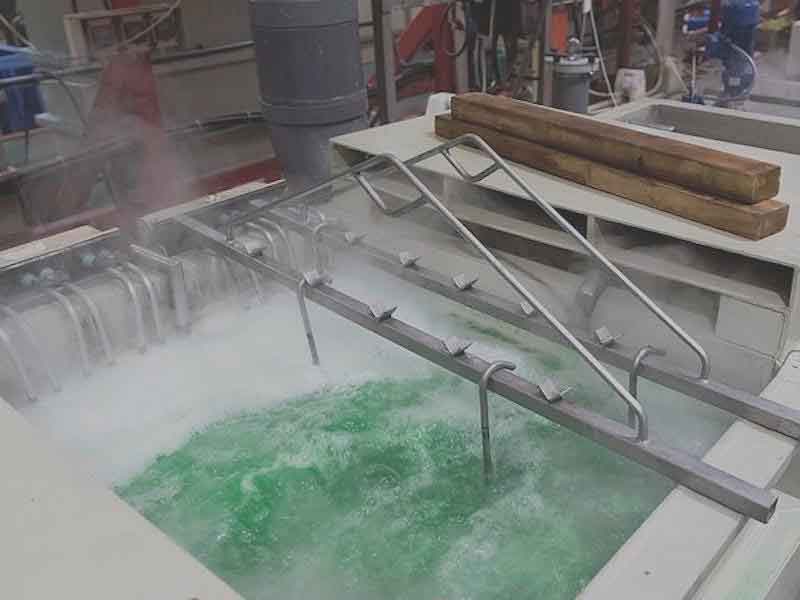Electroless nickel has been and continues to be in popular demand for a variety of engineering, aerospace, automotive, medical, military, and similar related finishes.
 Stephen F. Rudy CEFProblems related to this process have been along “for the ride.” It is important to understand these problems, probable sources, and corrective action. These unwanted deposit conditions might include roughness, pitting, edge skip, and premature corrosion. Let us review some of these problems.
Stephen F. Rudy CEFProblems related to this process have been along “for the ride.” It is important to understand these problems, probable sources, and corrective action. These unwanted deposit conditions might include roughness, pitting, edge skip, and premature corrosion. Let us review some of these problems.
Metallic Contamination
Metals not part of the process may be introduced into the EN solution by drag-in of previous activation acid, attack on zincated aluminum surfaces, or an excess of proprietary EN additives (such as stabilizers and catalysts). Metals such as cadmium and lead (especially before RoHS) reduce the plating rate. Catalysts may destabilize the solution, resulting in decomposition. Plating on plastics (POP), which use precious metal catalysts, is a likely source.
Rinsing and, if possible, avoiding the use of plating equipment for POP and going directly into EN is recommended. Zincated aluminum parts should first undergo an EN strike (mildly alkaline bath) that sufficiently seals the zincate coating. Use of RoHS-compliant EN is additionally preferred to avoid the detrimental stabilizing effects of cadmium and lead. In general, metallic contamination can be very critical to the EN bath. As little as 15 ppm of specific metals (cadmium, lead, bismuth, chromium, copper, and tin), 15 ppm zinc, and 75 ppm iron, can make the difference to a properly operating EN bath.
Organic Contamination
Fine deposit pitting is a typical indication of organic contamination. This is normally a problem associated with incomplete surface preparation, likely poor soak or solvent cleaning. Oils and grease effectively “spot out” on the surface, especially after acid activation, forming a barrier to deposition of EN. To a lesser degree, improperly cured stop-off or lubricants dripping from operating equipment can also be a problem. It is usually optimum per production demands and time constraints to replace the EN bath. At the same time, correction of the identified problem needs to be accomplished.
Nitrates
Only a few ppm of nitrates can significantly affect the EN deposit. Problems occur, such as streaks, discoloration, and slow or no deposition. Two possible causes:
- Poor rinsing after a nitric acid containing desmut or zincate strip. Accurate test papers can be used to confirm nitrates in the EN bath. Correction is either to replace the EN bath or (but in both cases) improve rinsing between acid desmut and the EN bath.
- Improper rinsing of an EN tank that has been nitric acid stripped prior to new bath makeup. Thoroughly flush the tank after treatment. Then fill with water and use nitrate test papers to confirm negative. Another correction action uses disposable drop-in liners. Check the tank for plumbing, and drain to confirm if this option is viable.
Chlorides
This contaminant affects the desired corrosion protection of the applied EN deposit. This occurs as chlorides increase deposit porosity. The main culprit is poor rinsing of a previous hydrochloric acid or pickle. Either improve rinsing or eliminate chlorides in the acid. In fact, the etching or pitting of stainless steel EN tanks may also occur due to chloride contamination.
Orthophosphite
This is one problem that is inevitable. Every chemical reduction reaction is accompanied by an oxidation reaction. Orthophosphite is the oxidation product formed in a reaction occurring with the hypophosphite reduction of nickel. The analysis of orthophosphite can be tracked as the EN bath ages. Typically four grams of orthophosphite is formed for every gram of nickel that is reduced. Usually, a concentration of 100 150 g/L of orthophosphite significantly affects the desired corrosion protection and the appearance of the EN deposit. A turbid or milky appearing solution also indicates high orthophosphite. In fact, this solution color may also occur with high pH or low complexer.
In addition to these just-discussed contaminants, similar adverse conditions affect the EN bath performance.
The EN bath
Low deposition rates can be the result of low nickel, hypophosphite, pH, and/ or bath temperature. Other operating factors include a bath that is over-stabilized, low bath loading (surface area per bath volume), and excessive solution agitation.
No deposition in a newly prepared EN bath can be the result of low bath analysis, pH, temperature, or the presence of a significant metallic contaminant.
Pitting can be corrected with proper filtration and using bags rated for 1 micron. Tanks, pumps, liners, and piping should also be approved for EN application.
Rough deposits can be the result of poor filtration, low solution agitation, and shelf roughness (adjust the rack orientation of parts). Chemical sources are low bath stabilizers, rather large volume additions at one time, and high bath pH. Localized solution overheating is corrected by improving solution movement and circulation. Excessive workload per bath volume should be adjusted to the recommended ratio of surface area to bath volume.
Porous deposits can arise from suspended particles in solution, organic contaminants, porous base metal, and an aged EN bath (high in orthophosphite).
Non-uniform deposits can be the result of out-of-range EN bath operating parameters and insufficient surface preparation (specifically cleaning).
Deposit blisters can arise from poor surface preparation, an over-stabilized EN bath, or dragging contaminated rinses into the EN bath.
When making additions of nickel and hypophosphite additives, it’s best to first add one product additive, let it mix in for at least 15-20 minutes, then follow with adding the other product additive. Do not mix two different product additives together prior to making a tank addition.
A fully, continually functioning production bath should be analyzed regularly per 8-hour shift. The actual timing schedule for analysis can be determined to maintain at least 90% bath efficiency. Adhere to supplier recommendations for bath analysis and storage of product additives.
When the bath is not in use and cooled, keep it covered.
Stephen F. Rudy, CEF, is president of Chem Analytic LLC and has written extensively about the finishing industry. Visit www.chemanalytic.com or call him at 917-604-5001.



































